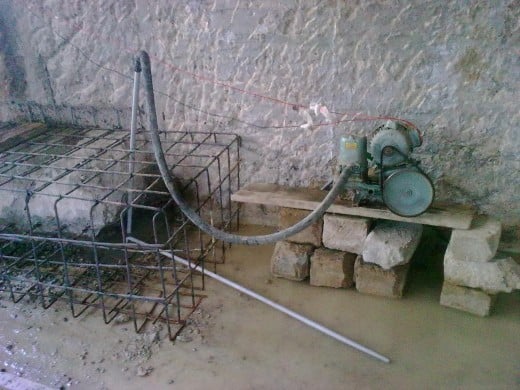How to Stop Running Water Coming from the Basement Raft via Concrete Jacketing
Following is an account along with pictures of every step, explaining how to fix a concrete basement raft leakage located 5 feet under water-table, caused due to faulty concreting. Actually the contractor did not tie the basement raft (floor) with a platform of pillar/column. Twenty years ago when he made the basement, the water-table was lower than the raft level which is why his mistake was not noticed at that time. But later when the water-table rose in D.H.A. Karachi due to water-logging, water started to oz out into the basement flooring. For some reason, the house took a long time and water started to pour into the basement before it was completed. Three attempts were made to waterproof the basement in two decades, but nobody tried to find out the actual cause and fixed it. Instead every waterproofer put another layer of CC floor, mixed with waterproofing chemicals over the flooring. This worked for a few months, before the water to come out of the new flooring again. These attempts increase the floor level up to a meter and thus reducing the height of basement.
Since the actual cause of leakage was hidden under the three layers of flooring, it was not possible to locate it without removing the entire one meter thick flooring of basement. When I was given this assignment, I first of all removed the whole flooring to investigate the raft and concrete joints. After removing the water through powerful pumps, we saw water coming out into the basement from near a pillar platform. Upon investigating it further, it was found that the whole joint of raft with a pillar platform was not tied properly and infect a cavity was left (1' wide and 10' long in "L" shape). The only way to fix such a huge void in basement raft is to do 'concrete jacketing'.
But the concrete jacketing cannot be done unless the water level is kept well below, the freshly poured concrete to allow the new concrete to set. In this case the leakage point was a few feet under the water-table, and the water may have burst out of the newly poured concrete before the concrete retains considerable strength to hold it. Even small water pressure would make the newly poured concrete to remain 'unset' and the whole procedure will fail. If that happens, the whole procedure needs to be repeated but after cutting and removing the concrete of previous attempt. Thus; all care and precautions should be taken to insure that the jacketing has to be successful in first attempt.
It requires two pipes to be placed inside the cavity; one pipe is connected to the vacuum suction pump that will keep sucking the water for as long the newly concrete is not set (usually 48 hours) and second pipe is the overflow pipe which is placed as a back-up, just in case the suction pipe fails-- either due to blockage of the opening of suction pipe that is submersed under the crush or the suction pump failure. After some 48 hours, the newly poured concrete has enough strength to stop the leakage sustaining the water pressure. Such a procedure is applied when the cavity from which the water is coming is wide and large enough for the usual water proofing methods to plug. In this case since the raft level was some 5 feet under the water-table, thus the water was coming out with speed. Following is the picture account of each and every step and can be used as a working manual for fixing leakages in concrete basements-- made well under the water-table where water pressure is involved.




















